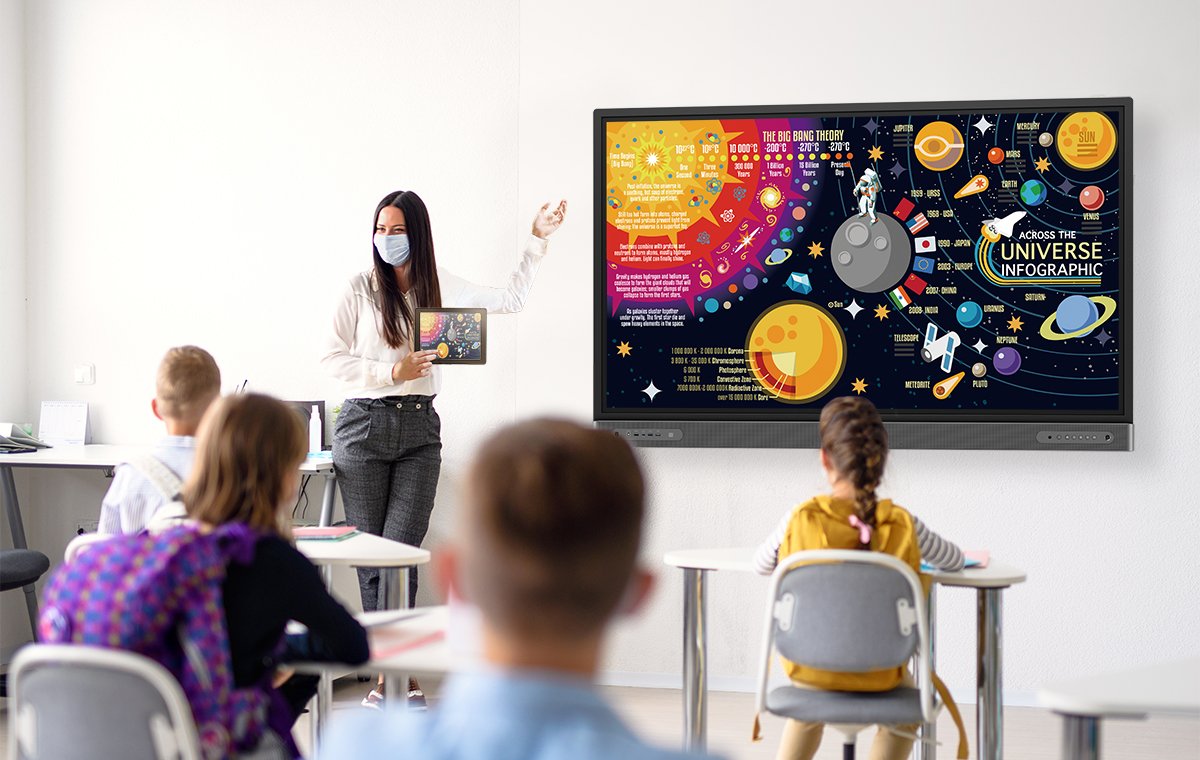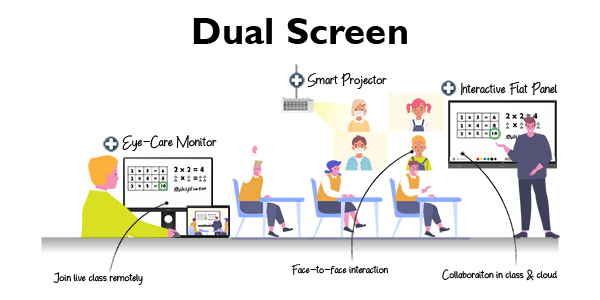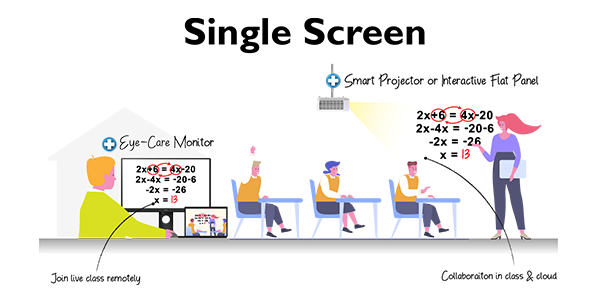COVID-19 has disrupted education around the world in big ways and disruptions are likely to be the new norm for educators. As teachers, we have to find a way to do our jobs by combining new health practices with pre-COVID teaching standards to give the same quality of education that students and parents expect from in-person classes. That’s where blended learning comes in, with the help of new tech like interactive smart board displays.
What is Blended Learning and Why Is It Important?
Today, one of the biggest challenges schools face is finding ways to keep learning spaces safe without compromising education. Distance learning may be here to stay, but teachers know face-to-face teaching still has benefits, like being more engaging and building skills like collaboration, teamwork, and leadership.
Blended learning combines in-person teaching with a remote environment. But what exactly is it? Blended learning, also known as hybrid learning, is about combining traditional face-to-face teaching with virtual teaching using technology like smart boards, conference calling, screen sharing, and self-study interfaces, often connected to using smartphones, laptops, and tablets. Blended learning combines the advantages of technology with the best parts of face-to-face teaching.
Today’s “classroom” is looking radically different. Teachers now have to consider health, collaboration, and equal-quality education for in-person and remote learning. Investing in education technology like BenQ’s interactive smart board displays is the best way to achieve these goals. Contact us to learn more.


How Has the Pandemic Impacted Schools?
A recent United Nations white paper estimates that 1.6 billion learners in 190 countries have been impacted by the pandemic. While the impact of school closures varies, the pandemic has no doubt harmed students’ quality of education, especially in schools that are less technologically advanced.
To keep both education and health standards, schools have to use tactics like staggering the return of students and scheduling attendance in shifts to keep the number of students in the classroom low. But these tactics aren’t enough on their own, and they don’t make up for lost teaching time. That’s where blended learning comes in.
Teachers are supporting schools moving toward blended learning. An online survey of teachers and administrators conducted by OECD found 57 percent of respondents favored a hybrid model of in-person and distance learning to accommodate social distancing. It’s time to make a new blueprint for interactive and collaborative learning.
Blended Learning Is the Answer to Education During COVID-19
So what are the benefits of blended learning and how can it fill the gap between traditional face-to-face teaching and remote classrooms?
Education technology, or EduTech, can be used to create virtual environments that replicate in-person classes. Blended learning courses can also include offline features. An offline learning space can be an advantage to students who can learn in a structured environment and receive immediate feedback.
Offline self-study works a lot like homework. It’s a great way to practice and reinforce the knowledge students gain in in-person classes, boosting understanding and retention. But unlike textbook homework, in-person classes have the advantage of being more interactive, accommodating more types of media, and catering to different learning styles.
Meanwhile, software with reporting features and data-driven insights allows teachers to gain insight into students’ progress and understanding. Offline learning environments can complement virtual face-to-face sessions to create a uniquely diverse learning experience for kids.
The Challenges of Blended Learning During a Pandemic
Stemming from technology-based education practices in the 1970s, blended learning is not new, but new technology has opened up a new world of possibilities, and blended learning now encompasses a lot more than it did in the past. Although technology has made blended learning a lot more practical and effective, adding it to school curriculum still comes with a unique set of challenges, including:
- Remote students may not receive the same quality education as in-person students
- Teachers have a harder time monitoring remote students’ reactions and levels of understanding in live classes
- Remote students are more vulnerable to distractions at home or online
- Remote students have less one-to-one engagement with teachers
- Students and parents may have difficulty using the technology
- Loss of physical social interactions with teachers and classmates may make students feel isolated
So the biggest challenge is delivering remote education that’s the same quality as in-person teaching. Overcoming this challenge involves using the right classroom display technology along with other virtual learning tools.
Smart Boards: A New Brand of Blended Learning
BenQ interactive smart boards are leading the evolution of blended learning. They overcome many challenges by using engaging displays, built-in cameras, mobile device connectivity, wireless screen sharing, and interactive functions (like a collaborative whiteboard) that’s available even to remote learners.
And since the collaborative whiteboard can be accessed remotely with EZWrite Digital Whiteboard, students can not only see, but also participate in whiteboards and lectures from their own devices.
If you’ve ever participated in an online class, lecture, or meeting, you know how difficult it can be to stay focused, and it’s even more difficult for young learners. But BenQ’s smart boards are able to recreate the live classroom experience with integrated video conference and interactivity to keep students engaged.
Smart boards provide the best of both worlds when it comes to face-to-face teaching and social distancing.




BenQ is proud to be able to deliver a new and improved version of blended learning that offers more flexibility to students and teachers. Students can access courses and materials from anywhere at any time while enjoying the benefits of face-to-face support and teaching. And teachers don’t have to worry about losing students’ attention or creating special lesson plans for online classes, since the smart board closely replicates a live teaching environment.
Today’s “classroom” is looking radically different. Teachers now have to consider health, collaboration, and equal-quality education for in-person and remote learning. Investing in education technology like BenQ’s interactive smart board displays is the best way to achieve these goals. Contact us to learn more.
